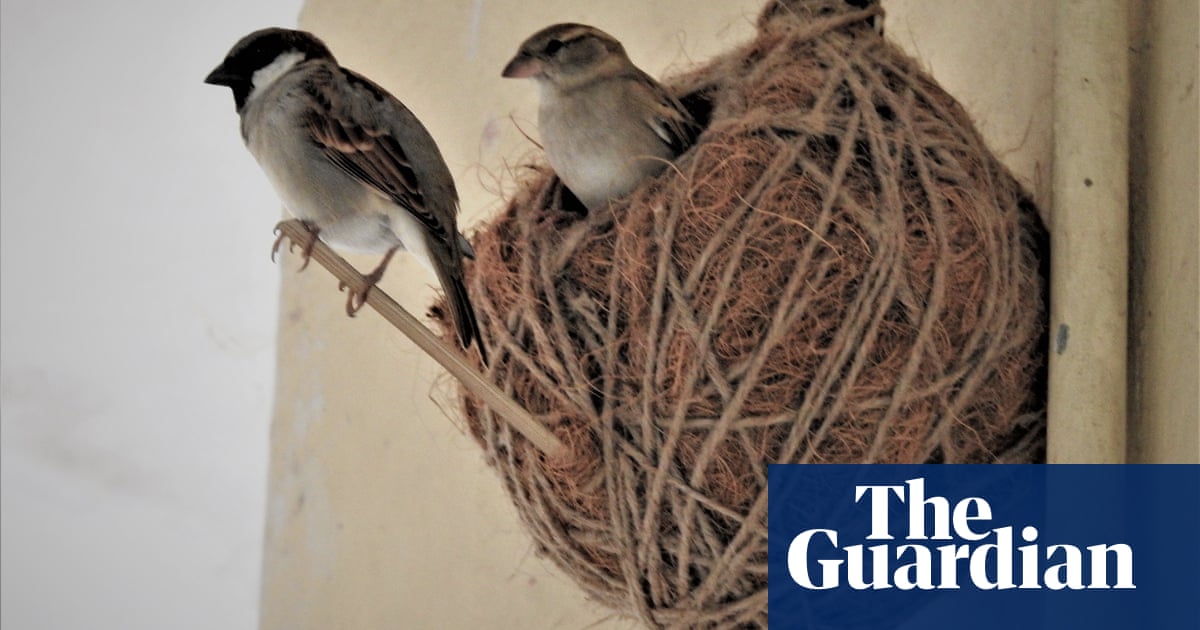
At the optimistically named Happy School, in a neighbourhood of Old Delhi, a gaggle of entranced children watch intently as they are shown how to weave together materials to make a sparrow’s nest.
Rakesh Khatri demonstrates how to use jute, coconut fibre, cotton, threads and a skeletal wooden frame to ensure the nest is durable. The children are then guided through building their own.
The “Nest Man of India” has now shared his techniques with thousands of children and adults in thousands of Indian schools. A passionate environmentalist, Khatri explains how these nests have provided vital shelter and protection to birds during the nesting season.
“We can’t build our houses by taking away their homes,” he tells the children.
Khatri’s own childhood memories are from the bustling lanes of Old Delhi, where he and his friends would feed the sparrows nesting in the nooks and crannies of houses and shops. He says the chirping of the tiny birds was a constant source of joy, and he was fascinated by their agility and resilience.
Through his frequent encounters with the birds, he developed an appreciation for nature and the importance of preserving it, he says. However, when he moved to a different area in Delhi, he noticed the dearth of sparrows. For Khatri, the rapid decline of the sparrow population in India, particularly since the late 1990s, is deeply concerning.
“On my way to my office in south Delhi, I would see a large number of birds that would give me great joy. One day I saw a couple of men cementing the holes in the pipes where birds had taken refuge. When I told them I would file a complaint with the National Green Tribunal, they stopped immediately,” says Khatri, referring to the statutory body that deals with environmental cases.
After that incident he started building nests – and he has never stopped.
“This city is turning into a concrete jungle. Earlier, people would make sure to leave spaces for these birds to build nests but now no one is bothered to think about it,” Khatri says.
In an effort to help conservation efforts, sparrows were adopted as Delhi’s state bird in 2012. But the species is still categorised as of “least concern” on the International Union for the Conservation of Nature (IUCN) Red List, which implies that it does not require significant conservation efforts.
Anecdotal evidence suggests that is not the case, says Khatri. “The declining population of this once-common bird highlights the need for increased awareness and conservation efforts to prevent further loss,” he says.
In 2012, Khatri established the Eco Roots Foundation, to raise awareness about declining bird populations and promote practices to provide nesting spaces. At workshops in more than 3,500 schools across India, Khatri has taught children and adults how to create bird nests using materials like twigs, grass, and leaves. His efforts have resulted in more than 100,000 nests being built, with a remarkable success rate of birds returning to them.
Sudipto Chatterjee is an associate professor at New Delhi’s Energy and Resources Institute, where Khatri has shown students his nest-building skills.
“The focus is on bringing together scientific knowledge and practical application to address the challenges faced by these birds and to promote their conservation,” he says. “Rakesh’s work is meaningful and we try to promote what he does so that more people are made aware of how the number of these birds have reduced due to habitat issues.”
On a walk through the lanes of Ali Vihar, in south-east Delhi, Khatri looks for the nest he installed there four years ago. Seeing sparrows in it delights him.
As he reaches home, he points to a pile of nests and materials. “We created these bird nests using empty Frooti juice boxes so that we could reuse these waste materials,” he says. “All the materials that we use are recyclable.”
Khatri is already planning his next workshop, to ensure that more of the birds have the homes they need to thrive.












